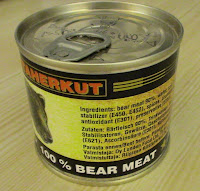Finland's Missing Bear Affair

In my collection of products with funny names there are also a few samples of products that don’t have a funny name but are odd in other ways. One of these is even odder than I first thought and – this will probably not surprise you by now – teaches us a valuable lesson in communications.
This product is a can of bear meat I picked up in Finland. Now you don’t get much bear meat in France so I thought that it was a handy thing to have around. Now when anyone asks what there is to eat I can say that they can choose between tuna fish and bear meat. So far nobody has been brave enough to try the bear. Wild people who like to live in the woods and eat anything they can kill tell me that it is very gamey. They recommend that you eat it early in the season before the bear has had time to eat too many disgusting things. Others suggest opening the can on a windy day.
But the most interesting part of this product is the label. There is a nice picture of the bear taken in happier times, “100% Bear Meat” written in letters you can read from the other side of the room and a list of ingredients. A list of what? If this is 100% bear meat why does it have to have a list of ingredients? Isn’t it going to say “Ingredient: bear meat?”
No it doesn’t. The ingredients list begins with “Bear meat, 90%” and then lists all the chemicals that make up the other 10%. Meat labeling laws are confusing to consumers, but I suspect that this packaging is perfectly legal though from a communications point of view it needs some work.
I think I understand what they mean: this can contains only the meat of bears and 90% of the content of the can is actual bear meat. This distinguishes it from those products where the meat is actually a cheap mixture of little bear and much more other animals that don’t need to be hunted one by one.
It is also possible, though, that the strange inconsistency is the fault of food labeling laws, where the meat content can actually be more than 100% because the definition of meat content is roughly the meat content of the ingredients expressed as a percentage of the final product weight. A can of corned beef, for example, typically needs 120g of meat to make 100g of finished product. In this way it is 120% meat, but the rules say that when the meat percentage is more than 100% it should not be expressed that way, but it is possible to label as 100% meat something that actually has other ingredients.
Whatever the reason this discrepancy looks very bad. Most consumers will assume that the maker is either an idiot or dishonest. You cannot expect consumers to be aware of all the byzantine labeling regulations and they will interpret percentages in the normal, everyday way. And the problem is easily fixable. Instead of 100% bear meat it would have been better to write something like “Only Bear Meat” or “All Bear Meat” if these are legal. Alternatively it is better to use formulas like “120g of meat used to make 100g of product” as recommended by the UK Food Standards Agency's interpretation of European Union rules at http://www.food.gov.uk/multimedia/pdfs/meatguidance.pdf. (Better not to read this just before a meal.)
Of course you could also argue that it was better to leave the bear in the woods and eat something else but that’s another story.


Comments